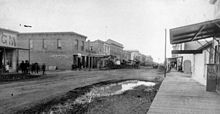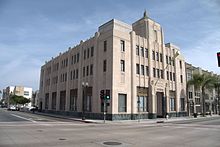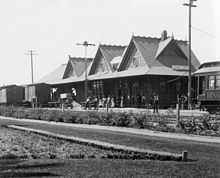Santa Ana
Santa Ana (Spanish for ‘Saint Anne’) is the second most populous city and the county seat of Orange County, California, in the Los Angeles metropolitan area.
History
Santa Ana was listed as a township of Los Angeles County in the 1860 and 1870 census, with an area encompassing most of what is now northern and central Orange County. It had a population of 756 in 1860 and 880 in 1870. The Anaheim district was enumerated separately from Santa Ana in 1870
Claimed in 1869 by Kentuckian William H. Spurgeon on land obtained from the descendants of Jose Antonio Yorba, Santa Ana was incorporated as a city in 1886 with a population of 2000 and in 1889 became the seat of the newly formed Orange County.
In 1877, the Southern Pacific Railroad built a branch line from Los Angeles to Santa Ana, which offered free right of way, land for a depot, and $10,000 in cash to the railroad in exchange for terminating the line in Santa Ana and not neighboring Tustin. In 1887, the California Central Railway (which became a subsidiary of the Atchison, Topeka and Santa Fe Railway the following year) broke the Southern Pacific’s local monopoly on rail travel, offering service between Los Angeles and San Diego by way of Santa Ana as a major intermediate station. By 1905 the Los Angeles Interurban Railway, a predecessor to the Pacific Electric Railway, extended from Los Angeles to Santa Ana, running along Fourth Street downtown. Firestone Boulevard, the first direct automobile route between Los Angeles and Santa Ana, opened in 1935; it was enlarged into the Santa Ana Freeway in 1953. The Pacific Electric Santa Ana Line ran from 1905 to 1958.
Santa Ana was the home of the original Glenn L. Martin aviation company, founded in 1912 before merging with the Wright Company in 1916. Later, Glenn Luther Martin created a second company of the same name in Cleveland, Ohio which eventually merged with the Lockheed Corporation to form the largest defense contractor in the world, Lockheed Martin.
Cityscape
Now fully developed, Santa Ana has several distinct districts. The core of the city is the downtown area, which contains both retail and housing, as well as the Santa Ana Civic Center, which is a dense campus of administrative buildings for both the city and the county of Orange. The civic center is also home to the Ronald Reagan Federal Building and Courthouse. Several historic homes dating from the late 1800s can be found as well, and their preservation is a key issue as development of the downtown area continues.
North of downtown is the “Midtown” district along Main St., home to entertainment destinations such as the Bowers Museum, MainPlace Mall, and the Discovery Science Center.
Near the intersection of the Santa Ana Freeway and the Costa Mesa Freeway is the newly designated “Metro East” area, which the city council has envisioned as a secondary mixed-use development district Currently the area is occupied by several office towers, but little retail or housing. Also on the east side of the city is the Santa Ana Zoo, notable for its collection of monkeys and species from South and Central America.
The southeast end of the city is part of the South Coast Metro area, which is shared with the city of Costa Mesa. South Coast Plaza, a major shopping center, is the primary destination of this area, which also contains several high-rise office and apartment buildings. Yokohama Tire Corporation’s United States headquarters are located at 1 MacArthur Place in the South Coast Metro area of Santa Ana, and Banc of California’s headquarters will relocate from neighboring Irvine to 3 MacArthur Place, Santa Ana, in 2016.
Geography
Santa Ana is located at 33°44′27″N 117°52′53″W (33.740717, -117.881408).
According to the United States Census Bureau, the city has a total area of 27.5 square miles. 27.3 square miles of it is land and 0.2 square miles of it (0.90%) is water. It is the 4th most densely populated place in the United States, with a population of 300,000 or more with 12,471.5 people per sq. mile.
Santa Ana is nested on flat, low-lying plains with little land elevation change. Running through the west end of the city is the mostly channelized Santa Ana River, which is also largely seasonal due to the construction of the Prado Dam and Seven Oaks Dam. The river has caused several severe floods in the 20th century, and is a continued threat despite the existence of the dams.



